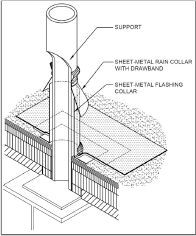The PV manufacturer is responsible for the installation of the actual PV system which should be completed in collaboration with a roofing contractor.
The following factors that need to be taken into consideration when installation a PV system.
Roof Age and Condition
The installation of a PV can be completed on both existing or new roof systems and should only be installed on roof assemblies that are in good condition.
The roof assembly below any PV system should have an expected service life equal to, or longer than the expected service life of the PV system, which is typically 25 years. This would help minimize any service disruptions during the lifecycle of the PV system. It is not recommended to install a PV system on a roof system that has less than a 10-year service life. When it comes time to replace the roofing system, the entire PV system will have to be removed in order to facilitate roof replacement.
On existing buildings, the condition of the roof system and the remaining length and details of any warranties must be verified. An inspection of the roof for damage, stress, or other existing problems must be completed prior to any installation work beginning. A moisture survey and cut tests should be completed in order to determine if the underlying components are in good condition. Damaged roof insulation and the additional weight of a PV system could cause greater damage.
Building Structure
The building structure must be reviewed by a professional engineer to ensure that it is suitable for the loads imposed by a PV. Additional loads could include the additional dead load from the weight of the PV equipment, greater snow loads, increased wind loads and possible impacts on wind uplift.
Roofing System
A roofing contractor must be aware of how best to incorporate the type of PV that is being installed on the roof system. An electrician or PV technician is required to oversee the proper installation of the entire PV system.
 All roof penetrations for both the mounting hardware and electrical equipment need to be carefully sealed to avoid any water penetration in the future.
All roof penetrations for both the mounting hardware and electrical equipment need to be carefully sealed to avoid any water penetration in the future.
Roofing assemblies that are used as substrates for PV should incorporate design enhancements such as:
- Each roof area shall be independently drained and have a positive slope, minimum 1:50 (2%).
- Increased compressive strength of insulation and coverboards.
- Increased thickness of single ply membranes.
